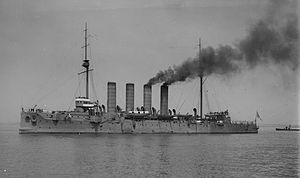Japanese cruiser Soya

Soya, formerly the Russian cruiser Varyag
|
|
| History | |
|---|---|
|
|
|
| Name: | Soya |
| Ordered: | 1898 |
| Builder: | William Cramp & Sons, United States |
| Laid down: | 31 October 1899 |
| Launched: | 2 January 1900 |
| Completed: | 14 January 1901 |
| Acquired: | by Japan as prize of war, 1904 |
| Commissioned: | 9 July 1907 |
| Fate: | Returned to Russia, 5 April 1916 |
| General characteristics | |
| Type: | Protected cruiser |
| Displacement: | 6,500 long tons (6,604 t) |
| Length: | 126.8 m (416 ft 0 in) w/l |
| Beam: | 15.8 m (51 ft 10 in) |
| Draught: | 6.1 m (20 ft 0 in) |
| Propulsion: | 4 reciprocating VTE engines; 2 shafts; 30 boilers; 20,000 hp (15,000 kW) |
| Speed: | 23 knots (43 km/h; 26 mph) |
| Range: | 4,500 nmi (8,300 km) at 10 knots (19 km/h; 12 mph) |
| Complement: | 571 |
| Armament: |
|
| Armour: |
|
Soya (宗谷?) was a protected cruiser in the Imperial Japanese Navy, acquired as a prize of war during the Russo-Japanese War from the Imperial Russian Navy, where it was originally known as the Russian cruiser Varyag.
Varyag was built in the United States by William Cramp and Sons of Philadelphia for the Imperial Russian Navy. It was stationed in Korea in 1904, and involved in the opening Battle of Chemulpo Bay of the Russo-Japanese War. After suffering heavy damage from the unequal battle with nine Japanese cruisers, Varyag was scuttled by its crew on 9 February 1904.
After the Russo-Japanese War, the Japanese raised the badly damaged wreck from Chemulpo harbor, repaired it, and commissioned it into the Imperial Japanese Navy as the 2nd class cruiser Soya on 9 July 1907. Its new name was taken from the northernmost cape of Hokkaidō, Soya Misaki.
After being placed into Japanese service as a 3rd class cruiser, Soya was used primarily for training duties. From 14 March 1909 to 7 August 1909, it made a long distance navigational and officer cadet training cruise to Hawaii and North America. It repeated this training cruise every year until 1913.
...
Wikipedia
